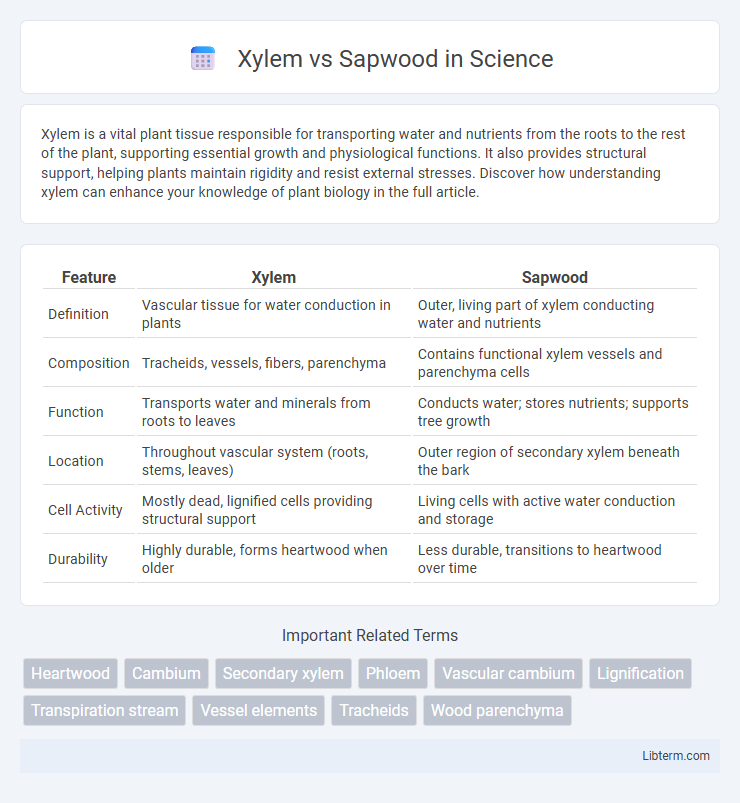Xylem is a vital plant tissue responsible for transporting water and nutrients from the roots to the rest of the plant, supporting essential growth and physiological functions. It also provides structural support, helping plants maintain rigidity and resist external stresses. Discover how understanding xylem can enhance your knowledge of plant biology in the full article.
Table of Comparison
| Feature | Xylem | Sapwood |
|---|---|---|
| Definition | Vascular tissue for water conduction in plants | Outer, living part of xylem conducting water and nutrients |
| Composition | Tracheids, vessels, fibers, parenchyma | Contains functional xylem vessels and parenchyma cells |
| Function | Transports water and minerals from roots to leaves | Conducts water; stores nutrients; supports tree growth |
| Location | Throughout vascular system (roots, stems, leaves) | Outer region of secondary xylem beneath the bark |
| Cell Activity | Mostly dead, lignified cells providing structural support | Living cells with active water conduction and storage |
| Durability | Highly durable, forms heartwood when older | Less durable, transitions to heartwood over time |
Introduction to Xylem and Sapwood
Xylem is the vascular tissue in plants responsible for the transport of water and minerals from roots to leaves. Sapwood, a part of the xylem, serves as the active conduit for this water transport and also stores nutrients, differentiating it from the older, inactive heartwood. Understanding the roles of xylem and sapwood is crucial for studying plant physiology and wood anatomy.
Definition of Xylem
Xylem is a type of vascular tissue in plants responsible for the conduction of water and minerals from roots to other parts of the plant. Sapwood, the outer, living part of a tree's secondary xylem, actively transports water, whereas heartwood, the inner part, primarily provides structural support. Xylem vessels and tracheids form a continuous network that enables efficient water movement through capillary action and transpiration pull.
Definition of Sapwood
Sapwood is the outer, living layers of secondary xylem in a tree, responsible for the conduction of water and nutrients from roots to leaves. It contrasts with heartwood, the inner, non-living xylem that provides structural support and is often darker due to deposit accumulation. While xylem includes both sapwood and heartwood, sapwood specifically refers to the active part of the xylem involved in fluid transport.
Formation and Structure Differences
Xylem forms from the vascular cambium through secondary growth, producing lignified cells that transport water and minerals from roots to leaves, while sapwood consists of the younger, functional xylem layers closest to the cambium. Xylem tissue includes tracheids, vessel elements, fibers, and parenchyma cells, whereas sapwood primarily comprises living xylem cells that retain water conductivity and storage capacity. The structural difference lies in sapwood's high moisture content and active sap conduction, contrasting with the older, non-functional, and often darker heartwood formed from aged xylem cells.
Primary Functions of Xylem
Xylem primarily functions in water conduction from roots to leaves, supporting plant hydration and nutrient transport essential for photosynthesis. It also provides structural support by lignifying cell walls, enhancing plant rigidity and resistance to environmental stress. Unlike sapwood, which contains living xylem cells facilitating active water transport, heartwood consists of inactive xylem that contributes mainly to mechanical strength.
Key Roles of Sapwood
Sapwood serves as the primary conduit for water and nutrient transport from roots to leaves, facilitating essential physiological processes in trees. It also functions in storage of starch and other carbohydrates, supporting metabolic activities during periods of dormancy or growth. The presence of living cells in sapwood contributes to wound repair and defense against pathogens, ensuring the overall health and longevity of the plant.
Xylem vs Sapwood: Composition and Color
Xylem consists primarily of lignified cells that provide structural support and conduct water, giving it a dense, woody composition. Sapwood, the outer, younger part of the xylem, has a lighter color due to higher moisture content and active water transport cells. The color difference between xylem and sapwood reflects variations in cell age, moisture, and chemical composition.
Importance in Plant Physiology
Xylem plays a crucial role in plant physiology by transporting water and minerals from roots to aerial parts, facilitating photosynthesis and nutrient distribution. Sapwood, the living outer layer of xylem, actively conducts water and stores vital nutrients, supporting both growth and repair processes. The efficient functioning of xylem and sapwood ensures plant hydration, structural support, and overall health maintenance.
Uses in Industry and Applications
Xylem serves as a vital component in industrial applications such as water transport systems, filtration devices, and bioengineering due to its natural ability to conduct water and nutrients efficiently. Sapwood, the outer layer of xylem, is extensively used in lumber and paper industries because of its mechanical strength and flexibility, making it suitable for construction materials and pulp production. Both structures contribute significantly to sustainable material sourcing and the development of eco-friendly bio-based products in various sectors.
Summary: Comparing Xylem and Sapwood
Xylem is a vascular tissue responsible for transporting water and minerals from roots to leaves, primarily composed of tracheids and vessels, whereas sapwood is the outer, living part of the xylem that actively conducts water and stores nutrients. Sapwood differs from heartwood by its lighter color and functional role in water transport, while xylem includes both sapwood and heartwood regions. Understanding the distinct functions and structures of xylem and sapwood is crucial for studying plant physiology and wood properties.
Xylem Infographic

 libterm.com
libterm.com